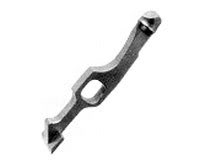
Hello folks I have a disconnector that kinda flops aroung in its hole and I have been looking for an oversize disconnector like that Chip McCormick High Tech 1911 Disconnector.
This advanced design eliminates creep and unwanted movement in trigger pull by only allowing the head to pivot, but not jump back and forth. A must for obtaining a perfectly crisp trigger pull.
Looks like it has a larger ring or something/
But I can't find any of those so what would you guys recomend as a good disconnector that may be a little oversized im also replacing the sear as well but I can't go with those $100 sets.
For some reason it's common to not mention the make of the frame/gun and that is pertinent information. If it's a Kimber or Springfield the disconnect hole is oversize as they use what I call a ball head disconnector. CMC doesn't make or supply small 1911 parts any longer. The only ball head besides Infinity's is a Bul part, or a Kimber part, Springfield will not sell them. The other choice is to swage the hole smaller. Here's the Bul part from Brownells.
It's an Armscor frame.
I'm a card-carrying skeptic. Sounds like Madison Avenue hype (a.k.a., hogwash) to me.
Niemi it is a ball head disconnector and is used by Kimber, Springfield and many custom guns such as Infinity. The idea is since it has a ball shape or ring, it can have very little fore and aft movement and go up and down in its full range. It's a variance going back to the National Match pistols. And looks like this.

From what you said in Post #2 I gather the frames that use the ball head disconnector don't have the little flange at the top?
Didn't follow flange at the top. The Kimber and Springfield are the same as others, Colt, but the disconnector hole is .008"-.010" bigger and unless you swag it down a standard disconnector is very sloppy.
Are we saying that a ball end shaped disconnector produces a line contact in the frame hole, reducing drag, and a cylinder shaped end disconnector has more surface contact, therefore increasing drag?
I prefer gun oil over snake oil.
Maybe a better term would have been shoulder or counterbore.
Ordnance blueprint shows disconnector hole through top of frame at 0.164 + .003 inch, but lower down it opens up to 7/32 inch (counterbored from below).
Not knowing if the ball head disconnector had a larger OD than the standard one (0.155 - .004 inch), was just wondering if it would fit in a standard frame with a 0.164 hole or if the hole would need to be enlarged.
Yes, the ball head style will work in a std. frame hole, but must be fitted, reduced slightly, as it is .162"-.164" in dia.and when done so is very smooth in it's operation. I used one earlier in '08 in an STI. The rub comes when someone uses a std. .155" head disconnector in a Springfield or Kimber and is unaware of this, as the frame hole in them is larger and the operation is sloppy, but will work. They have the counter bore also.
No, that's not quite the point, the ball head is more consistent in it's fore and aft clearance. It could be compared to a self aligning bearing, or the Briley bushing, The clearance necessary for it to move up and down without binding is less than with the original design. Friction is negligible in both designs.
Thank you for the information. I just checked government the 1911 print to see that the disconnector upper OD is .155 +0 -.004 and the frame hole is .164 +.003 -0. This creates a .009 to .016 loose fit.
I though that Briley bushings used a spherical shape for 1911 barrel bushings because the barrel pivots though the bushing like a tie-rod-end. The disconector moves in a straight path.
How is there an advantage to a ball end on the disconnector?
Quote:
The disconector moves in a straight path.
It moves in a straight path up & down provided the trigger stays put, but the back & forth motion of the trigger imparts a back & forth motion to the bottom of the disconnector, just like the back of the barrel goes up & down.
Quote:
How is there an advantage to a ball end on the disconnector?
See it now? Just like a Briley bushing for a barrel. Gives the disconnector less slop at the top. Don't really know if less top slop is a good thing, but others seem to think so.
I just watched the STI animation and get it now. I never realized that the disconnector pivoted too. This explains the 7-13 loose fit, why there is a square pin hole and also explains why there may be an advantage to a ball end.
Good thread, questions and answers and most importantly understanding and not bickering. The question of is it better, is a good one, one of the past disconnector improvements and still is, was to swag the hole down to the .155" and open it back up til free motion was had, this is really the same thing as the ball head in that it restricts fore and aft motion without binding. The swag produces a ring that isn't very thick. Interesting.
Quote:
Yes, the ball head style will work in a std. frame hole, but must be
fitted, reduced slightly, as it is .162"-.164" in dia.
Thanks Log Man. Posted those dimensions to an undimensioned outline drawing of it I just found on page 175 of J.K.'s Vol II. A little knowledge is a... well, you know the rest!
Gotta ask... Which type is the EGW disconnector?
The EGW disconnector is of standard design in a long version and needs fitting.